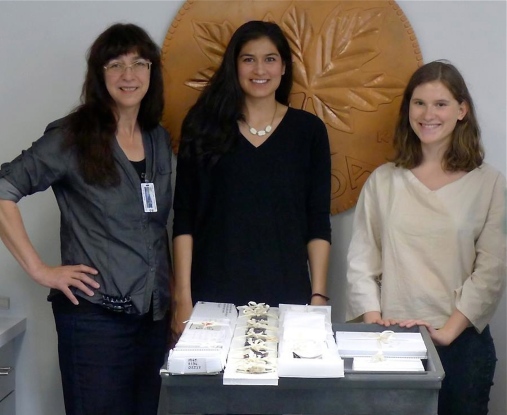
Margaret Bruchac, Stephanie Mach, and Lise Puyo at the Bank of Canada Currency Museum.
On the Wampum Trail: Restorative Research in North American Museums
In May 2014, three members of the “Wampum Trail” research team (Dr. Margaret Bruchac with research assistants Lise Puyo and Stephanie Mach) set out to follow a century-old trail left by wampum collectors, starting with University of Pennsylvania anthropologist Frank G. Speck. Our field research led us across the Northeastern United States and Canada, visiting museums with collections of wampum (woven shell bead) belts and collars. Our goal is survey these collections and conduct interviews to construct more detailed object histories for wampum belts in regional collections. With funding from the Penn Museum and the Department of Anthropology, we made an ambitious list of wampum in museum collections to examine. Our areas of focus included: collections that illustrate wampum manufacture (for example, Fort Shantok in Connecticut and the Campbell site in New Jersey); wampum belts connected with the Seven Nations Confederacy; and collections linked to individual collectors and museums.
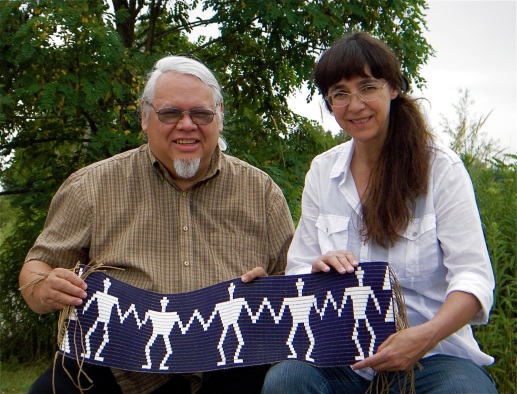
Richard Hill and Margaret Bruchac holding reproduction of the wampum belt depicting five chiefs/nations linking horns/holding hands.
We received encouragement and guidance from Haudenosaunee wampum expert Richard W. Hill (Tuscarora, Coordinator of the Deyohahá:ge Indigenous Knowledge Centre) who shared his foundational research on wampum, collected over the course of more than three decades of experience in museums and among Haudenosaunee Wampum-Keepers. Our goal was to chart the distribution of wampum belts into museums; along the trail, we discovered much more.
Background:
During the late 1800s and early 1900s, while anthropologists were conducting ethnographic research and salvage anthropology among various Haudenosaunee (Six Nations Iroquois) and Algonkian communities in the northeast, a number of wampum belts left the possession of Native nations and were sold to museums. At these museums—Harvard Peabody Museum, the Heye Foundation/Museum of the American Indian, McCord Museum, Penn Museum, and Canadian Museum of Civilization, among others—wampum was variously interpreted as decorative art, private property, relics of forgotten traditions, or items with mysterious origins. Although wampum belts in museum collections may appear to be vaguely labeled and poorly provenanced, our research suggests that some points of confusion actually result from curatorial misrepresentation or incomplete scholarship. Over time, Indigenous meanings have been replaced by misleading stereotypes and idiosyncratic interpretations. In many cases, more complete object histories can be compiled by close material analysis of the details of wampum construction and symbols, by collating records and photographic evidence from disparate sources, and by interviewing Indigenous knowledge-bearers.

Condoled Chief Curtis Nelson and Margaret Bruchac with six diamond wampum belt at the Mohawk Nation of Kanesatake, Oka, Quebec. This belt, which recorded Kanesatake’s connection to the Six Nations, was secretly removed in 1913 and sold (in company with three other wampum belts) by J.B. Delay to Frank Speck. Speck sold two wampum belts to Edward Sapir at the Victoria Museum (now the Canadian Museum of History) and two to George Gustav Heye at the Museum of the American Indian. In 2014, one of the four wampum belts was finally repatriated to Kanesatake. Photograph by Lise Puyo.
The team conducts interviews and provenance research using a restorative methodology that entails, not just examination of the objects, but close examination of the collecting processes and curatorial practices that have influenced the distribution, display, and interpretation of Indigenous objects in museum settings. We are also studying curatorial protocols that encourage respectful and productive research with Native communities, leaders, scholars, and artists. This wampum research is part of a larger project that tracks 19th and 20th century records of anthropological collectors, and investigates the social negotiations that shape museological understandings of Indigenous objects. By tracing and documenting object cartographies and object histories, we hope to revitalize connections between Indigenous objects in museums and contemporary Indigenous communities linked to those objects.
Reporting From the Field, Summer 2014
During the summer of 2014, our research took us into the collections of thirteen museums and five tribal nations across the northeastern United States and Canada, including: the Archives of Nicolet Seminary; Canadian Museum of Civilization (now the Canadian Museum of History); Kanehsatake Mohawk Nation; Mashantucket Pequot Museum and Research Center; McCord Museum; Museum of Currency; Ndakinna Education Center; New York State Museum; Peabody Essex Museum; Peabody Museum of Archaeology and Ethnology at Harvard University; Penn Museum; Tantaquidgeon Indian Museum; and the Yale Peabody Museum of Natural History, among others.

Lise Puyo with Archivist Benoît Thériault at the Canadian Museum of History, examining Marius Barbeau’s research on wampum. Photograph by Margaret Bruchac.
In general, we found that misrepresentations of wampum (such as the notion that wampum belts are inherently unidentifiable) reflected, not the erasure of Indigenous memories, but the influence of collecting processes that had separated these objects from their communities of origin. In some cases, we found that data housed in one museum, including correspondence among collectors, could shed light on supposedly mysterious wampum in another museum. Through close material analysis of individual wampum beads, strings, collars, and belts, we recovered a wealth of lost information about these old objects. Through interviews with curators, scholars, and Native American wampum keepers, we also gained new insights into wampum semiotics and display that reflect the evolving relations among Indigenous people and museums.
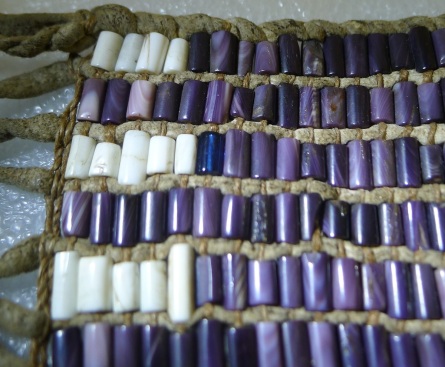
Detail of mid-18th century wampum belt showing the inclusion of a single blue glass bead in the original weave of whelk and quahog shell wampum beads. Photograph by Lise Puyo.
The most intriguing insights emerged from our observations of the physical details of wampum construction. We found previously overlooked evidence of all of the following: clear visual distinctions among different sizes and sources of shell beads (quahog, whelk, and conch); anomalous beads (stone, bone, clay, glass, rounded beads, and painted beads) in historic shell bead belts; various weaving materials (sinew, hemp, leather, linen, and cotton) and distinct patterns of twining warp and weft; various treatments of warp and weft, including rubbing with dye (red ochre, vermillion, ash, or paint), and wrapping, knotting, or braiding of edges and ends; and evidence of the re-use of older beads and leather warps in newer belts.
All of these details bespeak artisanal, aesthetic, practical, symbolic, and cultural choices, and they reflect savvy Indigenous technologies that deserve more careful analysis. After examining more than 50 wampum belts and collars, along with numerous collections of widely varying shell beads made from whelk, quahog, and conch, we realized that we had only just scratched the surface.
Reporting From the Field, Summer 2015
Current inventories indicate that there are more than 400 extant historic (pre-20th century) wampum belts in the collections of museums and Native American and Canadian First Nations tribes. Our hope is to recover as much data as possible on each of these objects, so as to restore their object histories, and reconnect them with each of their respective tribal nations. With that goal in mind, and with additional support from the Penn Museum, in May of 2015 the Wampum Trail research team set out for another round of research in northeastern museums. Two undergraduate student research assistants, Sarah Parkinson and Zhenia Bemko, assisted Project Director Dr. Bruchac and graduate research assistant Stephanie Mach. Our northernmost travels brought us to the Kitigan Zibi Algonquin nation at Maniwaki and Rapid Lake. Meanwhile, across the ocean, Lise Puyo continued her research on wampum collections in French museums.

Sarah Parkinson and Stephanie Mach at the Royal Ontario Museum, Toronto, ON. Photograph by Margaret Bruchac.
In May, during our visit to the Royal Ontario Museum, we examined a shell bead wampum belt that (although it was accessioned as a 17th century “William Penn wampum belt”) contains late 18th century beads pulled together with a highly unusual weaving technique. A forthcoming blog article will reveal more details.
At ROM, we were also delighted to discover that Frank Speck had initiated (but never completed) a comparative study of wampum shell beads from various sources, and the envelopes and samples he collected, including some very early examples of disc wampum beads, remained intact in their collections.

Rick Hill with reproduction wampum belts crafted by Ken Maracle, at the Great Law Recital. Photograph by Margaret Bruchac.
In July 2015, Marge Bruchac and Stephanie Mach were invited to attend the Haudenosaunee Recital of the Great Law at Akwesasne (for a glimpse of that event, see Stephanie’s field report). While there, we had the opportunity to study an assemblage of wampum belts that have been repatriated over the past several decades from the New York State Museum and other institutions, and that are now in the keeping of Onondaga and other Haudenosaunee nations. Each of these belts is remarkable; they all contain evidence of heavy use and, in some cases, reconstruction over time. During subsequent consultations with Haudenosaunee leadership, it became clear that the material evidence of repair and reconstruction we saw in these belts (including the occasional glass bead) is not a marker of inauthenticity. Instead, the evidence of repair and replacement and re-purposing is consistent with Indigenous practices of curation that preserve objects and traditions, not by locking them away or capturing them in a static form, but by engaging in continuous handling and renewal.
On October 1-2, 2015, Haudenosaunee and Algonkian scholars and tribal wampum researchers gathered together for a symposium at the Penn Museum to discuss wampum ceremonialism, diplomacy, materiality, and artistry in both Indigenous and museum contexts. See: Woven Words: New Insights into Wampum and Native Studies for more information, and photos on our Facebook page. Eventually, we will post some videos from that conference.
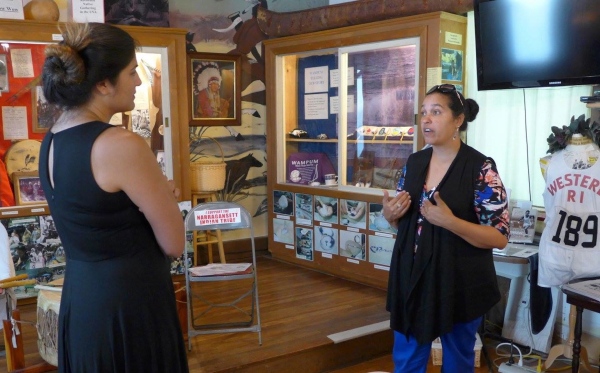
Stephanie Mach and Loren Spears at the Tomaquag Museum in Exeter, Rhode Island. Photograph by Margaret Bruchac.
Reporting From the Field, Summer 2016
Our travels in 2016 included return trips to the Canadian Museum of History and the Canadian Museum of Currency in Quebec, and to the Woodland Cultural Centre and Royal Ontario Museum (ROM) in Ontario, to re-examine wampum belts, ethnographic objects with wampum decoration, and depictions of wampum in museum exhibitions. We especially appreciated meeting up with Jonathan Lainey, one of the new Curators at CMH. In New York state, we spent several days with George Hamell at the Rochester Museum of Science and Industry, studying wampum samples in the Rock Foundation collections.
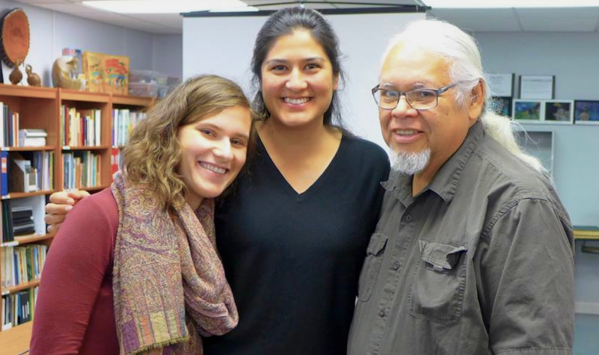
Lise Puyo and Stephannie Mach, meeting with Rick Hill at the Deyohaháge Indigenous Knowledge Centre. Photo by Margaret Bruchac.
Extending our studies to depictions of Native people and wampum in living history museums, we visited the Skä•noñh Great Law of Peace Center in Liverpool, New York, the Seneca Art & Culture Center at Ganondagan in Victor, New York, Plimoth Plantation in Plymouth, Massachusetts, the Aquinnah Cultural Center in Aquinnah, Massachusetts, the Tomaquag Museum in Exeter, Rhode Island, and the Mashantucket Pequot Museum and Research Center in Ledyard, Connecticut (see Lise Puyo’s field report on those visits). During our sojourn in New England, we also made some contacts with Aquinnah Wampanoag, Mashpee Wampanoag, Abenaki, Pequot, and other Native artisans who harvest quahog and whelk shells to craft wampum beads, belts, and jewelry. Thinking ahead to 2017, we look forward to future interviews along the shore with Marcus Hendricks, Jim Taylor, Annawon Weeden, and Berta Welch, among others.
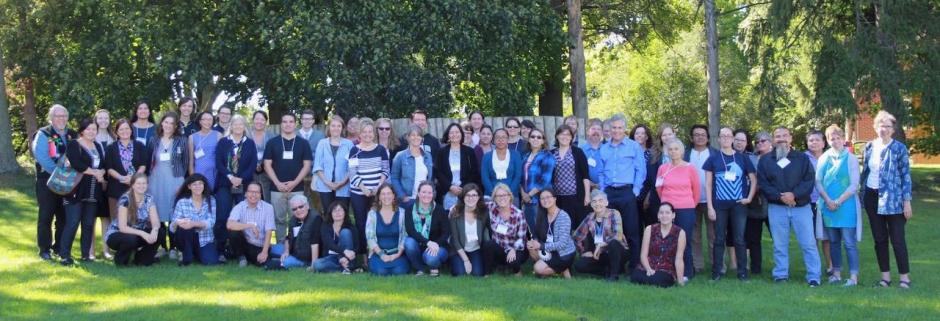 In September, the Wampum Trail team gathered together with an inspiring group of scholars, teachers, curators, and artisans during a meeting of the Great Lakes Research Alliance for the Study of Aboriginal Arts and Culture at the Woodland Cultural Centre in Brantford, Ontario. Many exciting projects emerged from that meeting. Rick Hill and Alan Corbiere are hoping to devise new research and instructional tools for teaching about wampum in Indigenous communities. Ruth Phillips from Carleton University and Adriana Greci-Green from the National Museum of Natural History hope to collaborate with Marge, Lise, and Stephanie to teach a new Museum Anthropology class, at each of their universities, focusing on applying restorative research in museum collections. In October 2016, the Wampum Trail team presented their research at the first international gathering of the Association for Tribal Archives, Libraries and Museums in Arizona.
In September, the Wampum Trail team gathered together with an inspiring group of scholars, teachers, curators, and artisans during a meeting of the Great Lakes Research Alliance for the Study of Aboriginal Arts and Culture at the Woodland Cultural Centre in Brantford, Ontario. Many exciting projects emerged from that meeting. Rick Hill and Alan Corbiere are hoping to devise new research and instructional tools for teaching about wampum in Indigenous communities. Ruth Phillips from Carleton University and Adriana Greci-Green from the National Museum of Natural History hope to collaborate with Marge, Lise, and Stephanie to teach a new Museum Anthropology class, at each of their universities, focusing on applying restorative research in museum collections. In October 2016, the Wampum Trail team presented their research at the first international gathering of the Association for Tribal Archives, Libraries and Museums in Arizona.
Reporting From the Field, Winter, Spring, Summer, Fall 2017
The Wampum Trail team followed a number of separate paths this year to conduct research in multiple locales. Marge Bruchac’s field research started in winter, with a snowy visit to the Rockies to examine some mysterious wampum belts and beads at the Denver Art Museum (DAM) and the Denver Museum of Nature and Science. There were a few surprises in the materials contributed to the DAM collections by Frank Speck, including a small sample of wampum-making debris from the Campbell “wampum factory” in Pascack, New Jersey, and two Mohegan bandolier bags made by Gladys Tantaquidgeon.
In Connecticut, Marge continued her studies of the archaeological material collected from the Mohegan wampum manufacturing site at Fort Shantok, and consulted with Elaine Thomas, Deputy Tribal Historic Preservation Officer and NAGPRA Coordinator, and James Quinn, Tribal Historic Preservation Officer and Archaeology Program Manager for the Mohegan Tribe. Now that most of the Shantok material has been repatriated to Mohegan, it is possible to make a better assessment of the entire assemblage. Bruchac sees Shantok as a remarkable example of what appears to be a cohesive Indigenous ceremonial complex: Mohegan people were harvesting mollusks, working the shells, making and drilling beads, and also making pottery on site at the very same location where they were conducting diplomacy and feasting.

Lise Puyo examining 17th-century rosaries at the Ursulines Museum, Trois-Rivières, Quebec, Canada. Photo by Josée Grandmont.
In May, the Wampum Trail team joined Diana Marsh of the American Philosophical Society to present a panel at the Council for Museum Anthropology Inaugural Conference at Concordia University in Montreal, Quebec, Canada. The panel, titled “The Challenges of Re-discovering and Re-presenting Hidden Indigenous Collections,” shared methods for investigating and identifying colonial-era Native American and First Nations materials (e.g., wampum belts, portraits, clothing, weapons) that, despite being widely exhibited, remain poorly understood.
Lise Puyo spent most of the summer field season in Quebec, tracking the records of 17th century exchanges of wampum, religious relics, and documents among the Jesuits (in France and in New France) and the Catholic Abenaki and Huron First Nations converts in Saint Lawrence communities. She visited the McCord Museum, Musée des Ursulines, Museum of Civilization, and Huron-Wendat Museum, among others. Lise is particularly focused on the glass beads in the 1676 Huron wampum belt sent to Chartres Cathedral. She notes, “the material and text of this belt offer a remarkable example of an Indigenous group conducting wampum diplomacy, not just with French missionaries, but also with Christian deities.”
Stephanie Mach traveled to New York City, and at the American Museum of Natural History, she viewed a collection of “Algonquian” wampum belts collected by Harriet Maxwell Converse; further research is needed to better identify and interpret these. At the National Museum of the American Indian George Gustav Heye Center, she also studied the cutting-edge designs with traditional inspiration on display in the “Native Fashion Now” exhibit, organized by the Peabody Essex Museum from Salem, Massachusetts. Stephanie is particularly interested in how Native individuals and communities navigate relationships through the use of wampum in ritual contexts, in museum displays, and in personal adornment. She notes that wampum is often assumed, in historical texts and popular interpretations, to be primarily “Iroquoian” even though the raw materials (whelk and quahog) historically came from Algonkian marine ecosystems. To better understand past and present wampum technologies, Stephanie plans to conduct interviews with Algonkian wampum-makers in New England regarding the specific techniques and relationships that shape their practice.

(left to right) Celeste Sherry, George Sherman, and Marge Bruchac at the Pascack Historical Society. Photo by Lise Puyo.
In July, Marge, Lise, and Stephanie met with George Sherman, President of the Pascack Historical Society in Park Ridge, New Jersey, in company with Celeste Sherry, who assisted with transcriptions. We also visited the original site of the “Wampum Factory” on Pascack Creek. Many secondary sources assert that the Campbells were making wampum beads here in the late 1700s, but in fact, the family did not settle in Park Ridge until 1808. There was a local cottage industry in small-scale hand-crafting and drilling shell beads, but the Campbell’s factory-style shellworking (as recorded in recently-recovered ledgers) started after a drilling machine was constructed during the late 1830s. The Campbell brothers primarily focused on mass-producing long “hair-pipe” beads from giant conch shells (salvaged from the Hudson River, where they had been dumped after being used as ship’s ballast). They sold those beads by the thousands to John Jacob Astor for the western Indian trade. We have seen examples of those beads in collections at Peabody Harvard, the National Museum of the American Indian, and, most recently, the Denver Art Museum.

Wampum Showcase project members Georgia Carley, Alan Corbiere, and Jessica Dolan meeting in Ohswken, Ontario in August 2017. Photo by Margaret Bruchac.
In August 2017, Rick Hill, Alan Corbiere, Georgia Carley, and Jessica Dolan joined Marge Bruchac for three days of talking, dreaming, and strategizing about wampum research at Bear’s Inn in Ohsweken, Ontario, Canada. The team worked on developing the Wampum Showcase Pilot Project with funding support from the Great Lakes Research Alliance for the Study of Aboriginal Arts and Culture. The goal is to collectively develop techniques for material analysis, documentary research, and cultural consultation that can effectively be used to identify poorly provenanced or otherwise mysterious wampum belts in museum collections. The group focused on three iconic but heretofore poorly understood wampum belts: a zigzag wampum belt with an attached beaver seal at the British Museum (see above image); the so-called “Great Wampum Belt of Union” at the National Museum of Natural History; and an unidentified glass wampum belt at the Royal Ontario Museum. The zig-zag belt is presumed to be Haudenosaunee; the other two are presumed to be Anishinaabe. In each case, the group successfully identified new details and gleaned new insights that cast further light on the origins and significance of each belt. In November 2017, Rick and Marge shared insights from some of the most recent wampum research at the 25th Anniversary Confernce at the Deyohahá:ge: Indigenous Knowledge Centre.
Watch this blog for more exciting news and upcoming reports on our travels and our research findings along the Wampum Trail!
____ ____ ____ ____ ____ ____ ____ _____ ____ ____ ____ ____ ____ ____ ____
For more information about the Wampum Trail research, see the following:
Blog Articles
• Lise Puyo. May 14, 2014. “Talking With the Belts at Harvard Peabody.” On the Wampum Trail.
• Lise Puyo. May 22, 2014. “Rummaging the Archives.”On the Wampum Trail.
• Lise Puyo. May 23, 2014. “The Glass Belt at the Archives of Nicolet Seminary.” On the Wampum Trail.
• Margaret M. Bruchac. June 21, 2014. “Of Shells and Ship’s Nails.” On the Wampum Trail.
• Margaret M. Bruchac. June 27, 2014. “Shells and Nails on the Wampum Trail.” On the Wampum Trail.
• Lise Puyo. July 18, 2014. “How Much Does Matter Matter? A Glass Wampum Belt at the Archives of Nicolet Seminary.” On the Wampum Trail.
• Stephanie Mach. July 19, 2014. “A Balancing Act: Traditional and Museological Care of Wampum.” On the Wampum Trail.
• Sarah Parkinson. May 26, 2015. “On the Rail to the Wampum Trail.” On the Wampum Trail.
• Margaret M. Bruchac. June 29, 2015. “Wampum Research: Notes From the Trail 2014-2015.” On the Wampum Trail.
• Zhenia Bemko. July 10, 2015. “Deconstructing Knowledge; Reconstructing Meaning.” On the Wampum Trail.
• Sarah Parkinson. July 14, 2015. “Of Words and Matter: Glass Wampum.” On the Wampum Trail.
• Stephanie Mach. September 2015. “Wampum Field Report Part 1: Blueberry Stands, Beaver Dams, and Mannequins.” On the Wampum Trail.
• Stephanie Mach. September 2015. “Wampum Field Report Part 2: Kaianerasere’Kówa.” On the Wampum Trail.
• Lise Puyo. July 2016. “Contemplating the Void: Peopling the Past in Living History Museums.” On the Wampum Trail.
• Stephanie Mach. April 2017. “Decolonizing Museums: A Visit to the Tomaquag Museum.” On the Wampum Trail.
• Lise Puyo. October 2017. “Encounters in the Cathedral: Revisiting the 1678 Huron-Wendat Wampum Belt at Chartres, France.” On the Wampum Trail.
• Margaret M. Bruchac. December 2017. “Weaving Interpretive Stories and Re-Awakening Wampum Objects and Archives in Museums.” Great Lakes Research Alliance for the Study of Aboriginal Arts and Culture.
• Lise Puyo. November 2023. “The Diplomacy of Transatlantic Christian Wampum.” Wampum: Beads of Diplomacy, McCord Stewart Museum.
Publications:
• Margaret M. Bruchac. 2017. “Materializing the Message in Wampum.” In Illuminations: A Guide to the 2018 Plays, edited by Eddie Wallace: 24-26. Portland, OR: Oregon Shakespeare Festival.
• Margaret M. Bruchac. 2018. “Broken Chains of Custody: Possessing, Dispossessing, and Repossessing Lost Wampum Belts.” Proceedings of the American Philosophical Society 162 (1): 56-105.
• Margaret M. Bruchac. March 1, 2020. “In Search of Wampum in England.” In Great Lakes Research Alliance for the Study of Aboriginal Arts and Culture Newsletter.
• Margaret M. Bruchac. 2020. “Visions of War: A 17th Century War Club Embedded with Wampum.” Historic Deerfield 18 (Autumn 2020): 40-45.
• Margaret M. Bruchac and Laura Peers. 2021. “Recovering Wampum in English Museums: The Search for Metacom’s Belts.” Journal of Museum Ethnography 34 (March 2021): 113-126.
• Lise Puyo. 2022. “The Huron-Wendat Belt at Chartres: Indigenous Negotiations With the Divine.” In Fluctuating Alliances: Art, Politics, and Diplomacy in the Modern Era, edited by Pilar Diez del Corral Corredoira, 57-75. Berlin, Germany: De Gruyter.
• Margaret M. Bruchac. 2022. “Of Animacy and Afterlives: Material Memories in Indigenous Collections.” In Invisible Labour in Modern Science, edited by Jenny Bangham, Xan Chacko, and Judith Kaplan, 71-80. Lanham, MD: Rowman and Littlefield International.
• Lise Puyo. 2022. Negotiating Between Shell And Paper: Wampum Belts As Agents Of Religious Diplomacy. Ph.D. Dissertation, University of Pennsylvania and École des Hautes Études en Sciences Sociales.
• [forthcoming] Margaret M. Bruchac. 2024. “A Pragmatic Approach to Reconciliation: Thoughts on Transforming Repatriation Practice.” In Pragmatism and the New Museum Anthropology, edited by Christina J. Hodge. London and New York: Bloomsbury Press.
Recordings:
• Margaret M. Bruchac. 2015. Audio recording. “Methodologies to Restore Meaning and Context to Indigenous Objects.” Association of Tribal Archives, Libraries, and Museums Summit, Washington, DC.
• Margaret M. Bruchac. 2015. Interviewed by Christina Cook for “Native American Studies Symposium Brings Wampum Experts to Penn.” Penn Current, University of Pennsylvania, Philadelphia, PA. September 24, 2015
• Margaret M. Bruchac. 2020. Video recording. “Listening to Object Witnesses: Decolonizing Research in Museum Collections.” Visiting Scholar in Museum Studies colloquium, University of Michigan, Ann Arbor, MI.
• Margaret M. Bruchac. 2020. Filmed interview for “The Making of the Wampum Belt.” Project Director Paula Peters, for Mayflower 400 United Kingdom.
Also check out the Wampum Trail Facebook page for reports on our latest research discoveries and travels.
